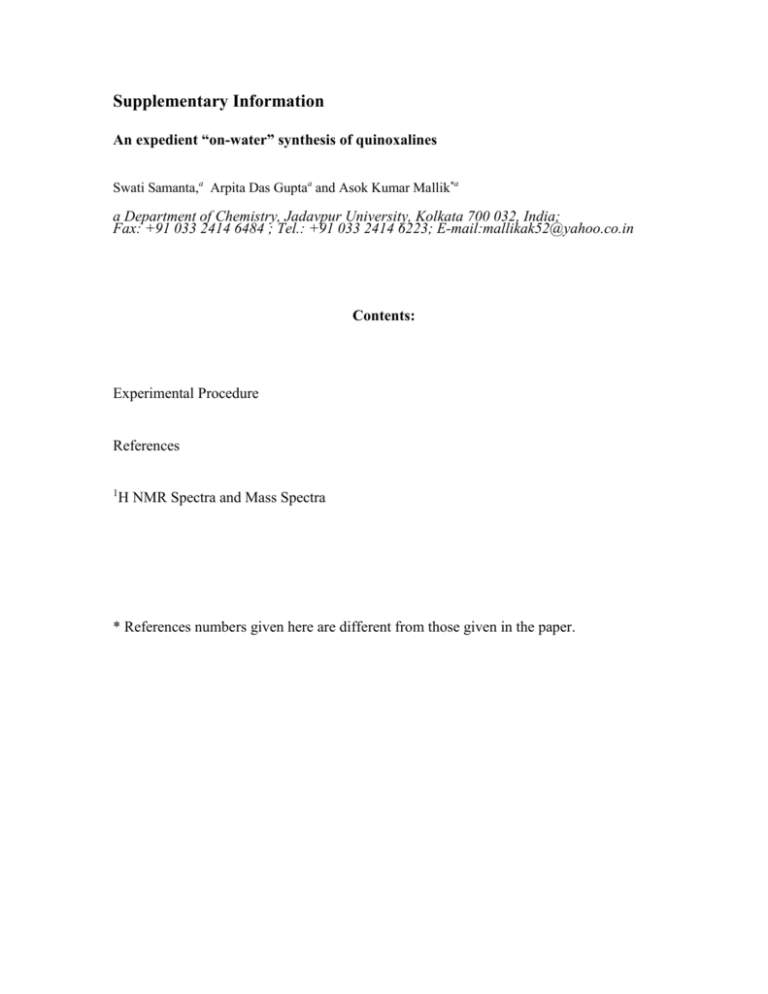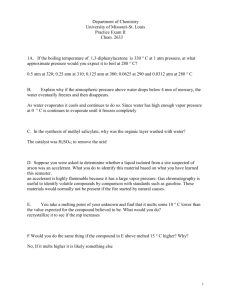Fig. 2 - Springer Static Content Server
advertisement

Supplementary Information An expedient “on-water” synthesis of quinoxalines Swati Samanta,a Arpita Das Guptaa and Asok Kumar Mallik*a a Department of Chemistry, Jadavpur University, Kolkata 700 032, India; Fax: +91 033 2414 6484 ; Tel.: +91 033 2414 6223; E-mail:mallikak52@yahoo.co.in Contents: Experimental Procedure References 1 H NMR Spectra and Mass Spectra * References numbers given here are different from those given in the paper. Experimental Procedure: Melting points were recorded on a Köfler block. IR spectra were recorded on a Perkin Elmer FT-IR spectrophotometer (Spectrum BX II) in KBr pellets. 1 H NMR spectra were recorded in CDCl3 or DMSO-d6 on a Bruker AV-300 (300 MHz) spectrometer. FAB MS was measured with a JEOL JMS-700 spectrometer and HRMS with a Waters HRMS instrument [Xevo G2QTof] spectrometer. Analytical samples were routinely dried in vacuo at room temperature. Microanalytical data were recorded on two Perkin-Elmer 2400 Series II C, H, N analyzers. TLC was performed with silica gel G made of SRL Pvt. Ltd. Petroleum ether had the boiling range 60-80 °C. General methods for synthesis of quinoxalines (5): A mixture of a 1,2-diketone (3, 1 mmole) and a 1,2-diamine (4, 1 mmole) was taken in 20 mL 5M aqueous NaCl solution in a 50 mL round bottomed flask. The mixture was then subjected to heating at 95ºC with vigorous stirring. After ca. 30 min of stirring the bulk of the suspended solid material was found to increase significantly indicating the occurrence of some change. Continuing the reaction for up to 4 h (depending upon the reactants) under the same condition, it was found to be complete (see Table 2 in the article). Then to the resulting mixture was filtered and the residue was dried and crystallized from ethyl acetate-petroleum ether. All the quinoxalines (5a-t) synthesized were characterized from their physical, analytical and spectral data. The spectral data of 5a-t are given in the sequel. Compound 5a (2,3-Diphenylquinoxaline): m.p.127 oC (lit. 126 oC [1]) IR; (KBr) υ max (cm-1); 3055, 1541, 1348, 1053, 771, 697. H NMR (300 MHz, CDCl3): δ 8.19 (2H, dd, J = 6.3 and 3.3Hz), 7.78 (2H, dd, J = 6.3 and 3.4Hz), 7.51-7.54 (4H, m), 7.30-7.39 (6H, m). 1 Anal. Calcd. for C20H14N2: C, 85.08; H, 5.00; N, 9.92; found C, 84.84; H, 4.82; N, 9.69. Fig. 1: 1H NMR Spectrum of 5a Compound 5b (Dibenzo[a,c]phenazine): m.p.219 oC (lit. 218oC [1]) H NMR (300 MHz, CDCl3): 1H NMR (300 MHz, CDCl3): δ 9.44 (2H, d, J=7.1 Hz), 8.55 (2H, d, J=7.5 Hz), 8.41 (2H, br. s), 7.88 (2H, br. d, J = 2.7 Hz), 7.75-7.83 (4H, m). 1 Fig. 2: 1H NMR Spectrum of 5b Compound 5c (Acenaphtho[1,2-b]quinoxaline): m.p. 240 oC (lit. 238-240 oC [2]) IR: (KBr) υ max (cm-1); 3443, 3047, 2922, 2361, 1614, 1481. 1 H NMR (300 MHz, CDCl3): δ 8.49 (2H, d, J = 6.7 Hz), 8.27 (2H, br. dd, J = 5.4 and 3.0 Hz), 8.14 (2H, d, J = 8.4Hz), 7.88 (2H, t, J=7.5 Hz), 7.79 (2H, t, J=5.4 and 3.0 Hz). Anal. Calcd. for C18H10N2: C, 85.02; H, 3.96; N, 11.02; found C, 84.84; H, 3.82; N, 10.69. Fig. 3: 1H NMR Spectrum of 5c Compound 5d (6-Nitro-2,3-diphenylquinoxaline): m.p. 193-194 oC (lit. 192-193 oC [2]) 1 H NMR (300 MHz, CDCl3): δ 9.09 (1H, d, J = 2.1 Hz), 8.30 (1H, dd, J = 9.3 and 2.2 Hz), 8.31 (1H, d, J= 9.3 Hz), 7.55-7.61 (4H, m), 7.35-7.44 (6H, m). Fig. 4: 1H NMR Spectrum of 5d Compound 5e (11-Nitro-dibenzo[a,c]phenazine): m.p. 258-259 oC (lit. 259-260 oC [3]) 1H NMR (300 MHz, CDCl3): δ 9.38 (2H, br. dd, J = 8.4 and 2.2 Hz), 9.23 (1H, d, J = 1.5 Hz), 8.54-8.61(3H, m), 8.43 (1H, d, J = 9.3 Hz), 7.87 (2H, t, J = 8.1 Hz), 7.79 (2H, t, J = 7.2 Hz). Fig. 5: 1H NMR Spectrum of 5e Compound 5f (9-Nitroacenaphtho[1,2-b]quinoxaline): m.p. 323-324 oC (lit. 321-323 oC [3]) H NMR (300 MHz, CDCl3): δ 9.12 (1H, d, J = 1.5 Hz), 8.48-8.54 (3H, m), 8.35 (1H, d, 9.0 Hz), 8.21 (2H, dd, J = 8.1 and 3.9 Hz), 7.93 (2H, J = 7.5 Hz). 1 Anal .Calcd for C18H9N3O2: C, 72.24; H, 3.03; N, 14.04; O, 10.69; found C, 71.98; H, 3.18; N, 13.91%. Fig. 6: 1H NMR Spectrum of 5f Compound 5g (6-Chloro-2,3-diphenylquinoxaline) : m.p. 116oC (lit. 115-116 oC [2]) Anal. Calcd. for C20H13ClN2: C, 75.83; H, 4.14; N, 8.84; found C, 75.01; H, 3.95; N, 9.04% 1 H NMR (300 MHz, CDCl3): δ 8.18 (1H, d, J = 2.1 Hz), 8.11(1H, d, J = 9.0 Hz), 7. 70 ( 1H, dd, J = 9.0 and 2.1Hz), 7.49-7.55 (4H, m), 7.30-7.40 (6H, m). HRMS (M+H)+ Calcd for C20H13ClN2: 319.0816(for 37Cl), 317.0845(for 35Cl); Found: 319.1086 (for 37Cl) , 317.1073 (for 35Cl) . Anal. Calcd. for C20H13ClN2: C, 75.83; H, 4.14; N, 8.84; found C, 75.01; H, 3.95; N, 9.04% Fig. 7: 1H NMR Spectrum of 5g Fig. 8: MASS Spectrum of 5g Compound 5h (11-Chloro-dibenzo[a,c]phenazine): m.p. 243-245 oC (lit. 243-244 oC [4]) 1 H NMR (300 MHz, CDCl3): δ 9.41 (2H, br. s,), 8.55 (2H, d, J =7. 8 Hz), 8.37-8.42 (2H, m) 7.74 - 7.83 (5H, m). Fig. 9: 1H NMR Spectrum of 5h Compound 5i (9-Chloroacenaphtho[1,2-b]quinoxaline): m.p. 225-227 oC (lit. 227-228 oC [5]) 1 H NMR (300 MHz, d6-DMSO): δ 8.43 (2H, d, J = 7.0 Hz), 8.34 ( 2H, dd, J = 8.1 and 1.6 Hz), 8.27 (1H, d, J= 1.8 Hz), 8.23 (1H, d, J =8.7 Hz), 7.95 (2H, t, J = 7.8 Hz), 7.87 (1H, dd, J =8.7 and 1.8 Hz). Fig. 10: 1H NMR Spectrum of 5i Compound 5j [Phenyl(2,3-diphenylquinoxalin-6-yl)methanone]: m.p. 147-149 oC (lit. 148-150 oC [6]) 1 H NMR (300 MHz, CDCl3): δ 8.55 (1H, s), 8.26 - 8.33 (2H, m), 7.91 (2H, d, J = 7.2Hz), 7.64 (1H, t, J = 7.4 Hz), 7.51 - 7.58 (6H, m), 7.32 - 7.41 (6H, m). Fig. 11: 1H NMR Spectrum of 5j Compound 5k: (11-Benzoyl-dibenzo[a,c]phenazine): m.p. 245-246 oC (lit. 245-248 oC [4]) 1 H NMR (300 MHz, CDCl3): δ 9.44 (1H, d, J = 6.0 Hz), 9.35 (1H, d, J = 6.3 Hz), 8.70 (1H, br. s), 8.58 (2H, d, J = 7.2 Hz), 8.47 (1H, d, J = 8.7 Hz), 8.35 (1H, d, J = 7.2 Hz), 7.98 (2H, d, J = 6 .9 Hz), 7.84-7.67 (5H, m), 7.59 (2H, t, J = 7.2 Hz). Fig. 12: 1H NMR Spectrum of 5k Compound 5l ((acenaphtho[1,2-b]quinoxalin-9-yl)(phenyl)methanone): m.p. 246-247 oC (lit. 245-246 oC [7]) 1 H NMR (300 MHz, CDCl3): δ 8.60 (1H, br. s), 8.49 (1H, d, J= 6.3 Hz), 8.42 (1H, d, J = 6.3 Hz), 8.33 (1H, d, J = 8.1 Hz), 8.25 (1H, d, J = 8.1 Hz), 8.15 ( 2H, dd, J= 7.5 and 4.5 Hz), 7.84-7.95(4H, m), 7.66 ( 1H, t, J=6.9 Hz), 7.53-7.58 ( 2H, m). Fig. 13: 1H NMR Spectrum of 5l Compound 5m (2,3-dihydro-5,6-diphenylpyrazine): m.p. 154oC (lit. 156 oC [1]) 1 H NMR (300 MHz, CDCl3): δ 7.41 (4H, dd, J = 7.9 and 1.8 Hz), 7.24-7.35 ( 6H, m), 3.72 ( 4H, s). Fig. 14: 1H NMR Spectrum of 5m Compound 5n (1,4-Diazatriphenylene): m.p. 178-180 oC (lit. 180 oC [8]) 1 H NMR (300 MHz, CDCl3): δ 9.20 (2H, br. d, J = 6.9 Hz), 8.89 (2H, s), 8.61(2H, br. d, J= 7.1 Hz), 7.72-7.80 (4H, m). FAB MS (M+H)+ Calcd: 231.2, Found: 231.2 Anal. Calcd. for C16H10N2: C, 83.46; H, 4.38; N, 12.17; found C, 83.21; H, 4.52; N, 11.95. Fig. 15: 1H NMR Spectrum of 5n Fig. 16: Mass Spectrum of 5n Compound 5o (8,9-Dihydroacenaphtho[1,2-b]pyrazine): m.p. 113-115 oC (lit. 113-116 oC [9]) 1 H NMR (300 MHz, CDCl3): δ 8.10 (2H, d, J = 6.9 Hz), 8.03 (2H, d, J = 8.4 Hz), 7.74 (2H, t, J = 7.5 Hz), 3.99 (s, 4H). C NMR (75 MHz, CDCl3): δ 158.6, 141.5, 131.8, 130.7, 128.5, 128.3, 118.6, 44.9. 13 Fig. 17: 1H NMR Spectrum of 5o 13 C NMR spectrum of compound 5o Fig. 18: 13C NMR Spectrum of 5o Compound 5p (2,3-Di(furan-2-yl)quinoxaline): m.p. 131-132 oC (lit. 131-132 oC [7]) IR; (KBr) υ max (cm-1); 3427, 2983, 1605, 1567, 1442, 879, 743. 1 H NMR (300 MHz, CDCl3): δ 8.15 (2H, dd, J = 6.3 and 3.3 Hz), 7.76 (2H, dd, J = 6.6 and 3.6), 7.64 (2H, br. s), 6.67 (2H, br. d, J = 3.3 Hz), 6.55-6.58 ( 2H, m). Fig. 19: 1H NMR Spectrum of 5p Compound 5q (2-Chloro-2,3-di(furan-2-yl)quinoxaline): m.p. 124-125 oC (lit. 124-126 oC [10]) 1 H NMR (300 MHz, CDCl3): δ 8.11-8.14 (1H, m), 8.03-8.09 (1H, m), 7.62-7.70 (3H, m), 6.69-6.72 (2H, m), 6.56-6.60 (2H, m). Fig. 20: 1H NMR Spectrum of 5q Compound 5r (2,3-Di-p-tolylquinoxaline): m.p. 141-142 oC (lit. 142-143 oC [11]) 1 H NMR (300 MHz, CDCl3): δ 8.15 (2H, dd, J = 6.3 and 3.3), 7.73 (2H, dd, J = 6.3 Hz and 2.8 Hz), 7.42 (4H, d, J = 7.1 Hz), 7.15 (4H, d, J = 7.8 Hz), 2.37 (6H, s). Fig. 21: 1H NMR Spectrum of 5r Compound 5s (6-Chloro-2,3-di-p-tolylquinoxaline): m.p. 170-172 oC (lit. 169-171 oC [12]) 1 H NMR (300 MHz, CDCl3): δ 8.15 (1H, d, J = 2.1 Hz ), 8.08 (1H, d, J = 9.0 Hz), 7.67(1H, dd, J = 9.0 and 2.1 Hz) 7. 42 ( 4H, d, J = 8.1 Hz), 7.15 (4H, d, J = 7.8 Hz ), 2.37 (6H, s). Fig. 22: 1H NMR Spectrum of 5s Compound 5t (Phenyl(quinoxalin-6-yl)methanone): m.p. 117 oC (lit. 117oC [13]) 1 H NMR (300 MHz, CDCl3): 8.95 (2H, br. s), 8.49 (1H, br. s), 8.25 (2H, br. s), 7.89 (2H, br. d, J = 7.7 Hz), 7.6 5(1H, br. t, J = 7.5 Hz), 7.53 (2H, br. t, J = 7.4 Hz) Fig. 23: 1H NMR Spectrum of 5t References: 1 H. V. Chavan, L. K. Adsul and B. P. Bandgar, J. Chem. Sci. 2011, 123, 477. 2 K. Niknam, D. Saberi and M. Mohagheghnejad, Molecules, 2009, 14, 1915. 3 S. Sajjadifar, M. A. Zolfigol, S. A. Mirshokraie, S. Miri, O. Louie, E. R. Nezhad, S. Karimian, G. Darvishi, E. Donyadari and S. Farahmand, American J. Org. Chem. 2012, 2, 97. 4 B. Karami, S. Khodabakhshi and M. Nikrooz, Polycycl. Arom. Compd., 2011, 31, 97. 5 J.-T. Hou, Y.-H. Liu, and Z.-H. Zhang, J. Heterocycl. Chem, 2010, 47, 703. 6 R. K. Sharma, Catal. Commun., 2011, 12, 327. 7 H.-Y. Lue, Australian J. Chem., 2010, 63, 1290. 8 F. Haftbaradaran, N. D. Draper, D B. Leznoff and V. E. Williams, Dalton Trans., 2003, 2003, 2105. 9 S. Sajjadifar, M. A. Zolfigol, G. Chehardoli, S. Miri and P. Moosavi, Int. J. Chem. Tech. Research, 2013, 5, 422. 10 J.-J. Cai, Tetrahedron Lett., 2008, 49, 7386. 11 D.-Q. Shi, and G.-L. Dou, Synth. Commun., 2008, 38, 3329. 12 H. Neumann, A. Brennfϋhrer, and M. Beller, Chemistry- A European Journal, 2012, 14, 3645. 13 V. K. Akkilagunta, V. P. Reddy and R. R. Kakulapati, Synlett, 2010, 17, 2571.








